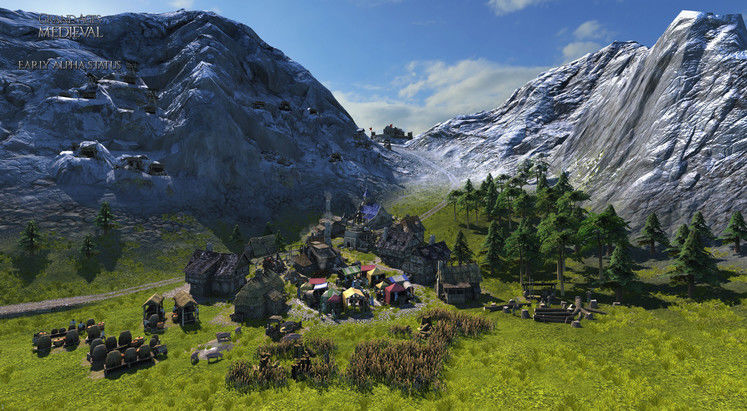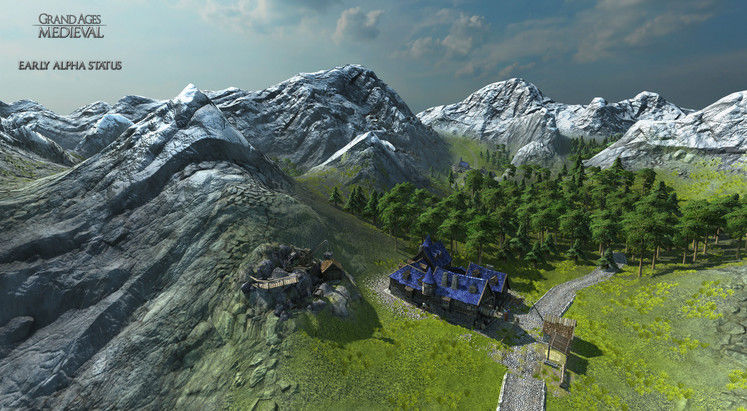The year is 1050, and you’ll be playing the role of empire-builder in the grand tradition of games such as Civilization. As such, the first task we see played out in our demo will be familiar to anybody with a background in Sid Meier’s finest. Medieval is being labelled as a “Global Conquer” game by the former Patrician and Rise of Venice developers, and like any good aspiring leader, you’ll first need to put down some roots.
 |
| The scale of the terrain is breathtaking |
In as much of an emotional sense as practical, that first township is key; it’s where you’ll find your initial batch of resources and research points, and it’ll also represent the heart of your sprawling conquests. Once you find a picturesque spot with good access to natural resources, the Medieval engine switches to an informational view in which to fine-tune your town placement, and soon after plonking down your very first construction, the fog of war lifts and allows an expanded view of your surroundings.
From that starting point, it’s a case of moving your settlers out into the world and finding new locations in which to prosper. Found another city and you can quickly establish links between the two settlements, ferrying construction goods from one to the other and allowing your regional influence to grow.
Ultimately, swift and proficient exploration of the map and removal of that fog will be key. It’ll found the basis of your tactical decision making and allow you to reach deep into foreign kingdoms, seeing threats and opportunities early. Founding new towns and cities gives you better control of any given region, accruing research points with which to advance through Medieval’s large tech tree and find new ways to increase productivity, lethality or otherwise improve the lives of your citizens.
With a landmass this large and diverse, trade should also form the cornerstone of your empire. Each of your towns will only produce a few different types of goods, but as your population grows and their influence reaches beyond their simple beginnings, they’ll begin demanding more. Alternatively, you might need to shift a large amount of a specific resource to a specific location in order to build a new structure, so well-defended and well-oiled trade routes are key to keeping everybody happy.
 |
| Industry is key to any budding empire |
On that note, goods created in one region can be manually traded at any other city as you please, but a good deal of work has gone into a robust trader AI that can handle things in your absence (with a world this big, micromanagement will quickly become unwieldy).
In its most basic form the AI trader will scurry around the landscape fulfilling the needs of your cities as best it can. As an example, if you station some troops outside a specific city they’ll need feeding from its stores, so the AI should automatically double-down its efforts to bring food to cope with the sharply increase in demand. Balancing that effect on your other population centres will be a necessary consideration however, as will protection for your trade wagons as they trundle around the map carrying precious cargo.
Your ultimate goal in feeding those troops will likely be testing out Medieval’s military credentials, and although combat is pretty much a necessity should you expand your empire far enough, I was also assured that peaceful methods of diplomacy or bribery will be open for use throughout any campaign. Precious little was shown of the combat itself during the time we had with this early build of Medieval, but we were promised something Civ-like in complexity and depth.
 |
| Conquer the continent |
There should be plenty of options to pursue, then. Throughout the demo, Grand Ages: Medieval was constantly referred to as a sandbox game more than anything else, with the developers keen to emphasise that there is no specific route to success. A few well-designed and fortified large cities could perform just as well as a large network of smaller townships, while success will likely depend on adapting your production, military and diplomacy efforts to the terrain, the AI or the human opposition.
It’s shaping up nicely, and although the comparisons to Civilization are inevitable given the subject matter, Grand Ages: Medieval is a different beast when you consider the impact of the brilliantly rendered 3D landscape and real-time game clock. There are no turns and hexes to consider, and although the pace is considered and slow enough to digest, it’s different enough to its rivals. Those elements alone will hopefully enable Medieval to stake a claim for its own territory.




